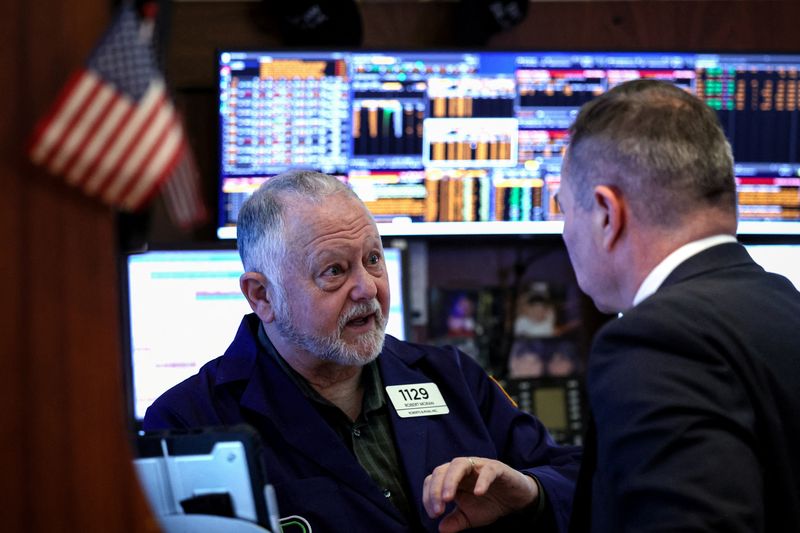By Lewis Krauskopf
NEW YORK (Reuters) - Some market participants believe the relentless U.S. stock rally is poised for a breather, even if it remains unclear whether equities are in a bubble or a strong bull run.
The benchmark S&P 500 index is up over 25% in the last five months, a phenomenon that has occurred just 10 times since the 1930s, according to BofA Global Research. In an advance led by stunning gains in chipmaker Nvidia (NASDAQ:NVDA), the S&P has already made 16 record highs this year, the most in any first quarter since 1945, CFRA Research data showed.
Bullish investors argue those gains stem from solid fundamentals, rather than the type of rampant speculation that has accompanied past bubbles. Oft-cited reasons include a strong U.S. economy, expectations the Federal Reserve will cut interest rates this year, and excitement over the business potential of artificial intelligence.
Yet some investors believe the market's nearly uninterrupted ascent means a pullback is due. The last time the S&P 500 slid more than 5% was in October, though BofA data shows such sell-offs historically occur three times per year on average. The index is up 8.5% this year.
"A lot of good news is priced into the market," said Michael Arone, chief investment strategist at State Street (NYSE:STT) Global Advisors. "From my perspective that just suggests that the risks are skewed to the downside."
It is not immediately clear what could cause a market sell-off. While stronger-than-expected inflation has dented expectations for how deeply the Fed will cut rates this year, many believe borrowing costs are still heading lower. Elevated consumer prices have also been seen as evidence of economic strength.
Investors have largely dismissed other concerns, from pockets of instability in U.S. regional banks to China's lackluster economy.
Nevertheless, some indicators are flashing a warning. The S&P 500's weekly relative strength index (RSI) - which gauges whether stocks are overbought or oversold - has climbed to just over 76, a level it has rarely topped since 2000, Miller Tabak data showed.
Significant sell-offs followed the last two times the index exceeded those levels: a 10% drop in the S&P 500 in January 2018 and a 30% plunge as COVID-19 emerged after the index topped that level in January 2020.
"None of this means we're looking at a major long-term top," said Matt Maley, chief market strategist at Miller Tabak. "However, it does tell me that we're getting ripe for a material pullback."
Growing investor optimism has also raised concern. The percentage of investors expressing a bullish view about the six-month outlook for stocks rose to 51.7% in the latest weekly survey from the American Association of Individual Investors, only the fourth time the bullish level has topped 50% in nearly the past three years.
High optimism is often viewed as a contrarian indicator because it means the bar for positive surprises is elevated.
"The sentiment backdrop right now ... makes the market vulnerable to a turn lower," said Kevin Gordon, senior investment strategist at Charles Schwab (NYSE:SCHW).
History shows the current advance may be primed for a pause. The S&P 500 erased losses from the prior bear market when it hit a record high on Jan. 19, and has advanced about 7% since then.
That is in line with past rallies, when stocks kept climbing after breaching new highs. Those moves, however, were followed by declines of at least 5% in the 12 times such a situation occurred, said Sam Stovall, CFRA's chief investment strategist.
BUT IS IT A BUBBLE?
For some, the market's optimism - coupled with parabolic moves in shares of Nvidia and other AI-focused companies - has evoked comparisons with past periods when asset prices soared to unsustainable heights only to come crashing down, such as the meme stock rallies of 2021 and the dot-com surge of 1999.
Nvidia's shares are up over 80% this year after tripling in 2023, making it the third most valuable U.S. company. Other AI-linked stocks have posted tremendous year-to-date gains, including Super Micro Computer (NASDAQ:SMCI), which has soared 300% and is set to join the S&P 500.
Nvidia has shown a strong relationship with S&P 500 performance, JPMorgan strategists wrote.
"We caution investors that this relationship is likely to work in reverse when the AI euphoria peaks," the strategists said.
Others, however, note differences with bubbles of the past.
Keith Lerner, co-chief investment officer at Truist, wrote that the S&P 500 technology sector's three-year outperformance against the broader S&P 500 stands at about 30%.
That is roughly in line with the 30-year average and far from the peak of just above 250% in March 2000, Lerner said.
And there seems to be little indication of euphoria in the new issue market, where initial public offerings have been comparatively muted.
Only 54 companies had IPOs in 2023, compared with 311 in 2021, before the S&P 500 peaked in January 2022, said Nicholas Colas, co-founder of DataTrek Research.

"Sentiment has warmed up on equities since mid-2023 ... but is nowhere near bullish levels of prior market peaks," wrote Savita Subramanian, equity and quant strategist at BofA Global Research. The bank recently raised its year-end target on the S&P 500 to 5,400 from 5,100. The index closed at 5,175.27 on Tuesday.
"In our view, this bull market has legs," she said.